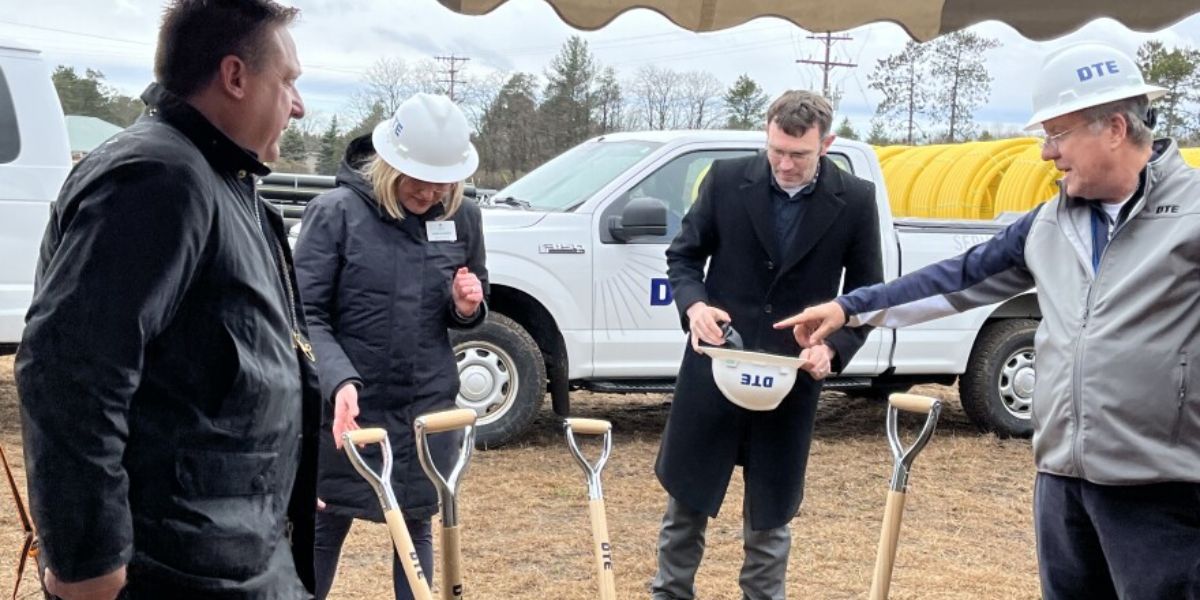Amidst Environmental Debates, Northern Michigan Welcomes Natural Gas Initiative
The rainy and windy Friday afternoon in April proved unsuitable for a groundbreaking ceremony. But Buckley Mayor Takis Pifer was all grins.
“How big a deal is natural gas? “It’s massive,” he stated.
DTE Energy is to install approximately 20 miles of pipeline to provide natural gas to families and businesses in the Mesick and Buckley communities.
Pifer, who formerly worked as an analyst for DTE, stated that most people in the area heat their homes with propane or wood stoves, so giving them another fuel option makes sense.
The project’s pricing is one of its most appealing features. According to DTE, it will reduce heating expenditures. That, combined with a quick payback period for customers, decided to pursue the project simply, Pifer added.
“Propane was good, but natural gas is considerably more affordable. That is why it has emerged as the clear front-runner,” he explained.
More than three-quarters of Michigan households rely on natural gas for heat, and it is the dominant source of power.
The use of natural gas for power has increased even as the state’s climate plan intends to reduce fossil fuel consumption and achieve carbon neutrality in the next decades. According to the International Energy Agency, this development is consistent with the fuel’s rise in the US energy sector, which has been aided by decreased pricing. (The IEA also predicts that demand for natural gas to heat homes and businesses in the United States will fall, thanks in part to federal subsidies for heat pumps and energy efficiency measures.)
As the state attempts to shift away from fossil fuels, some see projects like this as a positive step forward, while others see them as a negative investment.
Natural gas is primarily composed of methane. And methane is highly powerful, trapping heat in the atmosphere far more effectively than carbon dioxide.
“We call it methane gas or fossil gas because it is a fossil fuel,” said James Gignac, who coordinates policy in the Midwest for the Union of Concerned Scientists, an organization that supports science-based policy solutions and has long been a climate change advocate.
Experts say what we name fuel is important. A 2020 Yale study discovered that Americans viewed natural gas significantly more favorably than oil or coal, and connected it with terms like “environment” and “clean,” but methane was associated with terms like “greenhouse” and “climate change.”
While burning natural gas emits slightly fewer emissions than propane and is preferable to wood, Gignac emphasizes the importance of considering the overall footprint.
“There’s also leakage from the gas production and transportation system from where it’s extracted and then moved through pipelines,” he went on to say. “So methane gas is a significant contributor to climate change pollution.”
While industries around the country have long praised natural gas as a greener energy source, the Environmental Protection Agency reports that leaks occur throughout the manufacturing and transportation process. Last July, the environmental think group RMI calculated that a leakage rate of just 0.2% might equalize gas’s climate impacts with coal.
Following a massive methane leak at a Pennsylvania storage reservoir in 2022, the federal government began implementing new regulations for gas storage facilities, as well as plans to fine corporations that release methane.
Michigan’s MI Healthy Climate Plan recommends reducing dependency on natural gas. However, the state has not avoided gasoline, which can be less expensive than other fuels commonly used in rural areas.
The Mesick-Buckley project received $7.28 million from the state for what the Public Service Commission referred to as “low-carbon energy infrastructure.” This made the project viable, covering a large portion of the estimated $17 million cost.
Moving away from coal is critical to decreasing emissions, according to Gignac, but those efforts should prioritize electric heating over gas. “It’s really important to carefully scrutinize any proposed investments in building new gas plants when we have these alternative technologies that we need to be focused on ramping up as quickly as possible,” he told reporters.
DTE is revamping its business model, announcing plans to close its last coal-powered facility by 2032. Ultimately, the utility intends to achieve net-zero carbon emissions by 2050. And it has maintained that natural gas is a critical component of its shift away from coal.
Proponents have long referred to it as a “bridge” fuel between traditional fossil fuels and renewable energy sources such as solar.
But critics disagree.
“What they’re calling a bridge fuel—really, it’s a bridge to nowhere because we’re in the midst of a climate crisis,” said Ashley Rudzinski, the climate and environment program director with Groundwork Center for Resilient Communities, a nonprofit in northern Michigan.
Rudzinski is frustrated that DTE is still investing in natural gas.
“It’s really important to invest locally and invest in systems that are going to improve our energy security and the reliability of our grid,” she told reporters. “And for us, that means renewable energy.”
Back in Mesick, the groundbreaking ceremony for northern Michigan’s newest natural gas project drew politicians, realtors, a school superintendent, and contractors together under a tent. Huge coils of pipes and excavators sat waiting in the background.
“Natural gas is one of those ways that we’re reducing our carbon footprint,” said Scotty Kehoe, DTE’s Greater Michigan gas operations director. “While natural gas might not be a renewable energy source, it is a very clean energy source.” Michigan has the greatest natural gas storage capacity of any state, accounting for over one-eighth of total storage across the US.
According to Kehoe, DTE may acquire and transport gas from Ohio and Pennsylvania, then store it in natural underground reservoirs until it is ready to be distributed to customers. This enables businesses to purchase gas at low prices during the summer and, according to Kehoe, sell it at lesser prices during the winter.
Kehoe does not anticipate it going away very soon.
“I believe that natural gas will always have a place and a responsibility in the foreseeable future, in helping us provide that safe, reliable heat source and energy production while helping us to get to whatever that future technology is that gets us to our ultimate goals,” he went on to say.
For those who want to completely abandon fossil fuels, the future appears bleak.
DTE has stated that the project will be completed and ready to distribute gas by the end of the year.










